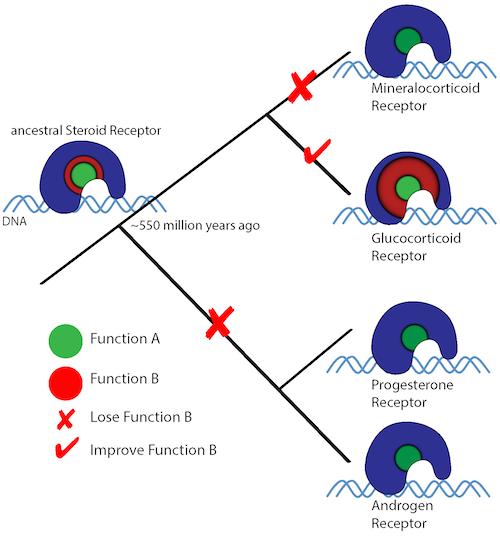A mechanism by which stress hormones inhibit the immune system, which appeared to be relatively new in evolution, may actually be hundreds of millions of years old.
A protein called the glucocorticoid receptor or GR, which responds to the stress hormone cortisol, can take on two different forms to bind DNA: one for activating gene activity, and one for repressing it. In a paper published Dec. 28 in PNAS, scientists show how evolutionary fine-tuning has obscured the origin of GR’s ability to adopt different shapes.
“What this highlights is how proteins that end up evolving new functions had those capacities, because of their flexibility, at the beginning of their evolutionary history,†says lead author Eric Ortlund, PhD, associate professor of biochemistry at Emory University School of Medicine.
GR is part of a family of steroid receptor proteins that control cells’ responses to hormones such as estrogen, testosterone and aldosterone. Our genomes contain separate genes encoding each one. Scientists think that this family evolved by gene duplication, branch by branch, from a single ancestor present in primitive vertebrates.
When GR turns genes on, two protein molecules grasp each other while binding to DNA. When it turns genes off, the two protein molecules bind on opposite sides of the DNA helix, adopting a slightly different shape to do so. The repressive mode is thought to be responsible for the inhibitory effects of cortisol and GR on the immune system. The other steroid receptor family members only bind DNA in the activating mode.
With collaborators from University of Chicago (Joe Thornton — intriguing 2012 profile of him), Georgia State (Ivaylo Ivanov) and Scripps Research Institute (Douglas Kojetin), Ortlund’s laboratory has been examining the structure and function of steroid receptors from organisms that are now extinct. The researchers “resurrect†the ancient proteins through computer analysis and then synthesis. They were surprised to find that an ancestral steroid receptor – giving rise to the modern day steroid receptors, including GR (see figure) — could bind DNA in both activating and repressing modes.
“We tested the present-day receptors first, and saw that only GR, out of the five steroid receptors, had the ability to bind DNA repressively,†says lead author Will Hudson, PhD, a former Molecular and Systems Pharmacology graduate student at Emory. “So we presumed that this distinctive function of GR’s must have been a relatively recent development in the course of evolution.â€
“Instead, it looks like GR’s repressive DNA binding activity goes way back, and that subsequent mutations shut that activity off in other family members besides GR,†Ortlund says.
Additional investigation showed that the mutations that squelched steroid family members’ ability to bind DNA repressively didn’t affect the part of the protein that directly contacts the DNA. Rather, they affected its flexibility and its ability to adopt different shapes.
Human understanding of how GR shuts genes off is also relatively recent; how steroid hormones activate genes has been understood roughly since the 1980s, but the paper describing repressive DNA binding by GR was published in 2011.


